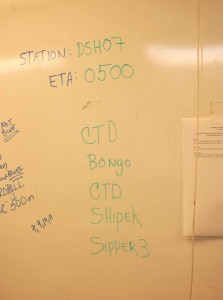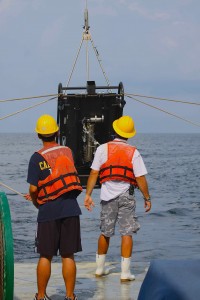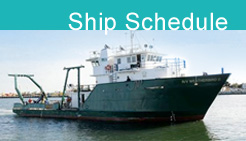Deep Sea Fish and Sediment Surveys in the Gulf
Later on Friday
Friday, part II posted by K.Bylsma, Teacher at Sea for C-IMAGE
The schedule has been revised again. We’re towing SIPPER III again, because Sipper IV is not operational ( water in the CPU, I think I overheard- robotics, keep this in mind when building).
Anyway, this am’s second set of tests were interrupted by breakfast ( remember, meal time is not amendable, says Thomas). Sue finished up the tests. Next thing I know, we’re bracing for the turbulence all day ( both sides of the DeSoto Canyon). PCB05 will be shallow compared to what we’re been sampling. What does that imply about the water chemistry or the quantity or diversity of the biomass ? That’s what the samples will tell us. All of this data has been collected on roughly 18 of these trips over the past 3 years , following the Deep Water Horizon.
 ETA is 2300, yes, that’s 11:30 tonight, again. You run the tests when you have the materials- RULE. ( This photo is an example of the task sequence at listed on the job board at each sampling site- not just this site)
ETA is 2300, yes, that’s 11:30 tonight, again. You run the tests when you have the materials- RULE. ( This photo is an example of the task sequence at listed on the job board at each sampling site- not just this site)
Had a discussion with Karl, the USGS representative who is studying ocean acidification. His samples are taken from the surface waters as the vessel continues to voyage. The instrumentation that he is using collects salinity, pH, temperature, O2, CO2, nitrogen, phosphorous. During my discussion with USGS, I asked about karst topography that is so specific to Central Florida. According to NGSSS, seventh grade is when our students learn about geology- tectonic plates, geologic time, and hopefully a bio/geo/chemical relationship. I am grateful that his expertise matched what I had researched for our kids. The erosion caused by acidifications in the limestone causes the collapses in the water table resulting in sinkholes. I had no idea that much of this karst region stretches from Alachua to Lee counties!! From this topic, we pursued phosphate mining in our region that results in some homes and businesses being built on the conversion of phosphate slag into radon —— a radioactive element. More on this chemical exchange later . Buyer beware. We also included the environmental hazards of wetlands construction (or restructuring) because of the similar chemical conversions.
Finally, and related to the DWH event… what happens to real estate where a gas station once was located? Not to be paranoid, but gas lines leak into the layers of soil/ bedrock/ etc and become trapped. How long does it take to completely remove carbon based fuels from organic matter ? Is it ever truly gone? Not according to the Law of Conservation of Matter.
What does all this have to do with the DWH event or the data being collected? It’s the study of human impact on the environment and the critical balance that has to be maintained.
Check these out –
http://sofia.usgs.gov/publications/maps/florida_geology/
http://water.usgs.gov/ogw/karst/kigconference/abt_karstfeatures.htm
http://fipr1.state.fl.us/PhosphatePrimer/0/C8D7947AB36A400E85256F880077B8CA
| Print article | This entry was posted by greely on August 15, 2013 at 10:33 pm, and is filed under Oceanic Updates. Follow any responses to this post through RSS 2.0. You can leave a response or trackback from your own site. |


